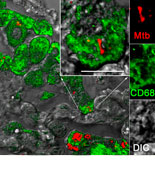 |
||||
Division of Bacteriology & Parasitology The Division is in the process of expanding its research areas by attracting new faculty to work on the pathogenesis and immunoprophylaxis of tuberculosis and with new research initiatives in the area of pathogenesis of pneumonia due to Streptococcus pneumoniae. Tuberculosis (TB), along with AIDS and malaria, is one of the three major infectious disease killers. One third of the world’s population is infected with Mycobacterium tuberculosis. Each year an estimated eight million people develop, and about two million people die of, TB. Understanding bacterial gene expression in vivo is central to unraveling mechanisms of disease caused by intracellular bacteria such as M. tuberculosis. Using microarray technology, our faculty is comparing gene-expression patterns of the TB wild-type organism with the expression patterns of M. tuberculosis that are deficient in certain regulatory genes. It is hypothesized that these regulatory genes play a crucial role in the process of adaptation of M. tuberculosis to the intracellular milieu, and hold the secret of this bacterium’s virulence. Division of Comparative Pathology Work on tuberculosis is focused on development of new vaccines and diagnostics. The vaccine work is a collaborative effort with investigators from Duke University, Albert Einstein College of Medicine, and Harvard University. In these studies, we are using gene deletion mutants of Mycobacterium tuberculosis developed by our collaborators and designated 6020 and 6030. These two deletion mutants are extremely safe in rodents and have been shown to be more effective at preventing tuberculosis (TB) than BCG. We have shown that these mutants are also safe in cynomolgus macaques, and we are in the middle of a protection study comparing 6020 and 6030 with BCG. We are also working on testing and developing improved diagnostic tests for tuberculosis. a rapid test has been developed that is an easy-to-perform, single-use diagnostic test for visual detection of antibodies to the mycobacterium that cause tuberculosis. This format provides a test that is simple (requires neither electricity nor expensive equipment for test execution or reading, nor skilled personnel for test interpretation), rapid (turn around time less than 15 minutes), safe (minimizes handling of potentially infected specimens), non-invasive (requires 30 ml of serum), stable (can keep at least 18 months without refrigeration) and highly reproducible. We are currently testing the reliability of this kit in normal non-infected monkeys, false-positive skin test animals, and monkeys experimentally infected with tuberculosis to prove that it is specific, safe, and reliable for testing humans for the presence of the tuberculosis causing mycobacteria.
|
|
©2013 Tulane University |
